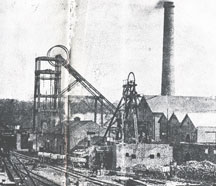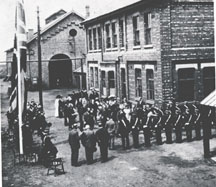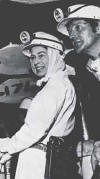|
INTRODUCTION

Silverwood Colliery was situated
between the Villages of Thrybergh and Ravenfield.
Towards the
end of the last century, when coal-mining was already a long-established
industry in Yorkshire, the shallow seams in the western sector of the
county-the easiest for the early miners to work by their primitive
methods-showed signs of becoming exhausted. So the private coal-owners of
the time cast their eyes towards the huge, but much deeper, reserves of
rich coal in the southern centre of the county. Two of the shafts sunk to
tap these valuable reserves of
the country's 'home grown 'fuel were at Thrybergh, three miles from
Rotherham ... and the colliery which was to grow into the Silverwood giant
was born. The shafts went down to the
Barnsley
seam, which was to become for many years the mainstay of Yorkshire mining.

But
even Barnsley seam, as vast as it was, couldn't last for ever. It served
Silverwood faithfully for well over 50 years, but the near-end of its life
coincided with a sudden change in coal's markets. For these two reasons,
Silverwood —after a brief spell in Meltonfield seam to help the
change-over-went still deeper into Swallow Wood seam-coal whose top-class
coking qualities are ideal to meet the growing demand for steel-making.
'Royal' Silverwood, gaining its proud title from two visits by reigning
Monarchy, is now reaping the harvest of the massive investment, especially
in opening up Swallow Wood, over the years. Further planned development
will maintain Silverwood's place among the mil lion-ton-a-year collieries,
making it one of the big-hitters of the Yorkshire
coalfield. By keeping up-to-date with the latest mining techniques-on the
surface as well as underground-Silverwood will continue to provide
employment for about 1,500 men, and make a valuable contribution to the
prosperity of the local community. Already more than 70 years old,
Silverwood has at least another half-century of good quality reserves to
work. And in that time, the colliery will play a leading part in the
industry's plans to make coal the largest and most efficient producer of
energy in Britain.
SILVERWOOD'S CHILDHOOD
Dalton Main Collieries Ltd. started shaft-sinking at Thrybergh in 1 900,
The
Barnsley
seam was reached at 741 yards, and the first coal came out of the new pit
in-1905.

Coal-getting at that time was the hard slog of shovel and
muscle. The coal was hacked from the face by pick, and shovelled into 1cwt
tubs for tramming to the pit bottom, horses providing the motive power for
the trains of tubs, The colliery remained in the hands of the Dalton
company until nationalisation in 1 947.
General Images of Silverwood
Colliery at stages
in its development
THE
COUNTRY'S BEST
The six-feet
thick Swallow Wood seam gave Silverwood the chance of setting new
standards of production and productivity, especially as it allowed
electrically-driven machinery to be used underground for the first time at
the colliery—the previous coal-cutting machines were driven by compressed
air. Silverwood accepted the challenge. The first 250-yard long face in
the new seam was carefully planned and designed by a joint team from
colliery and Area headquarters. It had two shearers, and coal-getting was
earmarked for only one of the three shifts in each 24-hour cycle -the two
non-coaling shifts were set aside for thorough maintenance of the
machinery and the necessary preparation work to enable non-stop operations
oh the coal-getting shift.
 The face teams were trained in the correct use of machinery quite new to
them. and teach-ins were held to show how each faceworker's job
dove-tailed into the intricate pattern of coal-getting operations. The
foresight paid big dividends. Month after month, Silverwood's first
Swallowood producing 7,000 saleable tons each week—one face on its own
had an output more than some small pits. The four faces now being worked
have huge ranging drum shearers which can travel along the face at about
20 feet a minute as they bite deep into the rich coal, which drops onto a
face conveyor at the start of its journey to the east shaft... and bunkers
are built-in the system to provide temporary storage in case of hold-ups
further along the route. The face machines and the conveyors are shielded
from the roof by the canopies of hydraulically-operated supports which
move forward under their own power as soon as the machine has passed. A
solid canopy of steel, they give safe protection for
the face-workers.
The face teams were trained in the correct use of machinery quite new to
them. and teach-ins were held to show how each faceworker's job
dove-tailed into the intricate pattern of coal-getting operations. The
foresight paid big dividends. Month after month, Silverwood's first
Swallowood producing 7,000 saleable tons each week—one face on its own
had an output more than some small pits. The four faces now being worked
have huge ranging drum shearers which can travel along the face at about
20 feet a minute as they bite deep into the rich coal, which drops onto a
face conveyor at the start of its journey to the east shaft... and bunkers
are built-in the system to provide temporary storage in case of hold-ups
further along the route. The face machines and the conveyors are shielded
from the roof by the canopies of hydraulically-operated supports which
move forward under their own power as soon as the machine has passed. A
solid canopy of steel, they give safe protection for
the face-workers.
Please note these
Photo's are copyright Jonathan Dabs courtesy of John Doxeys Silverwood
Site.
CLOSURE
The colliery finally closed in 1994 and had survived 94
years and had been a large employer of local labour. The colliery had many
highs and lows in its remarkable history and some milestones are listed
below:
SOME MILESTONES IN SILVERWOOD'S LIFE
1900 shaft-sinking began.
1905 coal-winning from the Barnsley seam.
1912 visit from King George V.
1929 record yearly tonnage of 1,322,501.
1 953 £3m re-construction scheme, including
development of Meltonfield seam.
1965 development of Swallowood seam and
modifications to coal prep. plant.
1969 Meltonfield seam abandoned.
1 972 further modifications to coal prep. plant costing
more than £1m. Barnsley seam closed.
1 975 visit from Queen Elizabeth II and Prince Philip.
1 975—76 rapid-loading bunker installed.
Top
Back to Articles |
